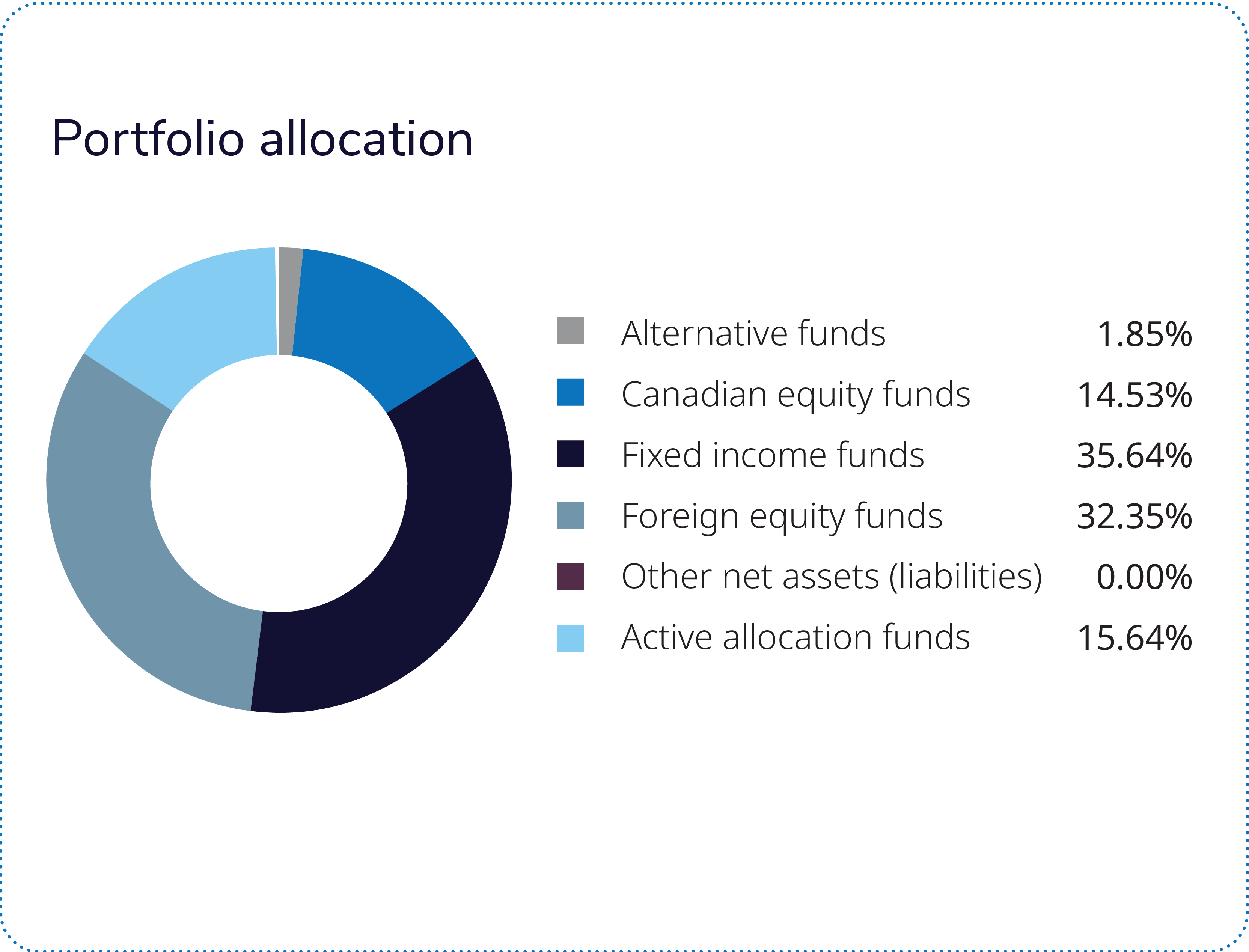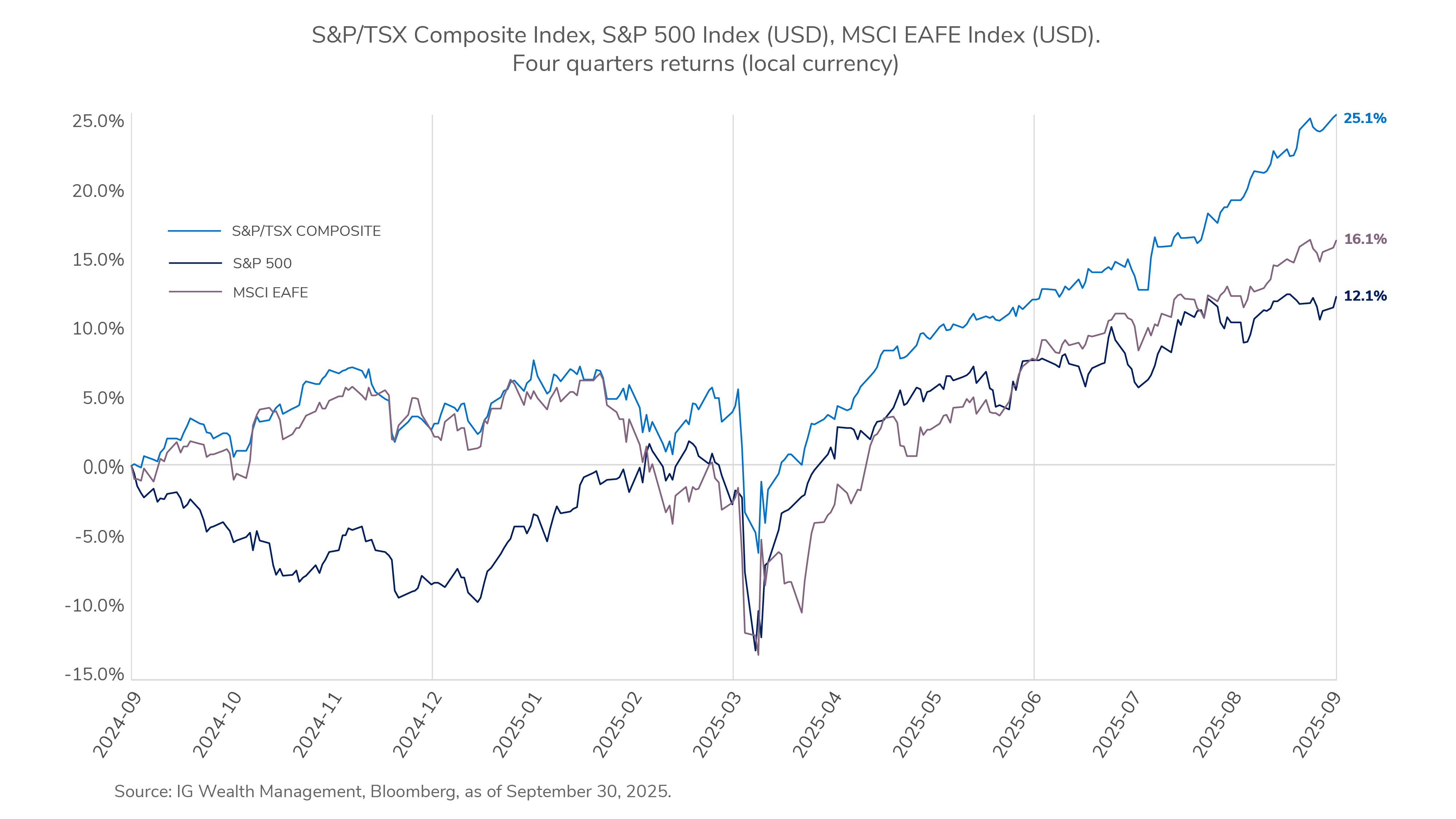Portfolio returns: Q3 2025
| Total Return | 1M | 3M | YTD | 1YR | 3YR | 5YR | 10YR | Since Inc. July 12, 2013 |
IG Core Portfolio – Balanced F | 2.98
| 5.40
| 9.20
| 11.47
| 12.76
| 8.11
| 6.62
| 7.14
|
Quartile rankings | 2 | 2 | 2 | 2 | 2 | 1 | 2 |
| Total Return | 1M | 3M | YTD | 1YR | 3YR | 5YR | 10YR | Since Inc. July 12, 2013 |
IG Core Portfolio – Balanced F | 2.98
| 5.40
| 9.20
| 11.47
| 12.76
| 8.11
| 6.62
| 7.14
|
Quartile rankings | 2 | 2 | 2 | 2 | 2 | 1 | 2 |
 The IG Core Portfolio – Balanced rose (by 5.4%) over the third quarter of 2025 and outperformed its global neutral balanced peer group median (4.9%). The portfolio benefited most from gains in its traditional equity components, especially North American equities. All fixed income components of the portfolio underperformed all equity components. As a result, fixed income, which comprises more than 30% of the portfolio, accounted for only 10% of the total return. The IG Mackenzie Real Property Fund was the only portfolio component to lose ground over the period.
The IG Core Portfolio – Balanced rose (by 5.4%) over the third quarter of 2025 and outperformed its global neutral balanced peer group median (4.9%). The portfolio benefited most from gains in its traditional equity components, especially North American equities. All fixed income components of the portfolio underperformed all equity components. As a result, fixed income, which comprises more than 30% of the portfolio, accounted for only 10% of the total return. The IG Mackenzie Real Property Fund was the only portfolio component to lose ground over the period.
Many equity indices, including the S&P 500 Index (total return 10.5% in Canadian dollars), the S&P/TSX Composite Index (total return 12.5%) and the MSCI EAFE Index (total return 7.2% in Canadian dollars) reached record highs during the period. Equities advanced almost steadily, with investors drawing comfort, first, from trade deals (or outlines of trade deals) that reduced U.S. tariffs (or threatened tariffs) with many trading partners, reducing uncertainty. Secondly, economic data remained surprisingly solid, especially in the U.S., and contained inflation pressures that allowed several central banks to lower benchmark interest rates, including the U.S. Federal Reserve, the Bank of Canada and the Bank of England. As a result, all equity components of the portfolio gained ground.
The best-performing portfolio component was the JPMorgan-IG Emerging Markets Pool. However, due to its relatively small weight in the portfolio, it had a limited impact on overall results. The Mackenzie-IG Canadian Equity Pool, with a return of more than 10%, was the next-best performer and was the top-contributing equity segment. However, it slightly lagged the S&P/TSX Composite Index, mainly due to an underweight exposure to the top-performing materials sector. U.S. equity components, including the Mackenzie-IG U.S. Equity Pool and the T. Rowe Price-IG U.S. Equity Pool, were also significant contributors. However, they too lagged their primary benchmark, the S&P 500 Index. The Fidelity-IG Canadian Equity Pool and the IG Mackenzie Pan Asian Equity Fund also ranked among the top performers, and the equity-heavy BlackRock-IG Active Allocation Pool II contributed more to the portfolio’s total return than any other segment, in part due to its weight.
Global fixed income returns were mostly modestly positive in the quarter, as bond yields slipped lower in North America but edged higher in Europe and Japan. Fiscal concerns (worries about increased government spending and inflation), in some cases related to political uncertainty, put upward pressure on bond yields in the U.K., France and Japan in particular. As a result, North American bonds outperformed international bonds. The Mackenzie-IG Canadian Bond Pool, which comprises more than 15% of the portfolio, was the portfolio’s top fixed income contributor, in part due to its weight. Putnam-IG High Yield Income Pool was the best-performing fixed income component, as high-yield bonds outperformed investment grade bonds, both corporate and sovereign, as credit spreads narrowed.
The third quarter delivered broad gains across asset classes, with market performance largely overriding a backdrop of cautious sentiment. Investors looked past persistent trade policy headlines, increasingly treating the U.S. administration's tariff policy as noise rather than a core risk. The primary catalysts for the positive performance were a subtle shift toward lower-interest-rate expectations and resilient corporate earnings.
Signals from the U.S. Federal Reserve of imminent rate cuts were followed by a quarter percentage cut in September. Government bond yields eased into the quarter's end, supporting bond prices, while corporate bonds outperformed government bonds.

Investors today face a familiar challenge: separating durable economic signals from short-term noise. While softening labour markets and a temporary pause in manufacturing activity have captured headlines, a deeper look reveals a fundamentally resilient and encouraging landscape for the markets ahead.
The most significant development was the successful normalization of inflation, which is now stable and within central bank targets. This has paved the way for an easing cycle, providing a supportive backdrop for the economy. More importantly, corporate America continues to demonstrate its strength. Earnings have once again surpassed expectations, with second quarter results showing impressive year-over-year growth. This combination of moderating inflation and robust corporate health provides a powerful engine for market performance.
Commissions, fees and expenses may be associated with mutual fund investments. Read the prospectus and speak to an IG Advisor before investing. The rate of return is the historical annual compounded total return as of September 30, 2025, including changes in value and reinvestment of all dividends or distributions. It does not take into account sales, redemption, distribution, optional charges or income taxes payable by any securityholder that would have reduced returns. Mutual funds are not guaranteed, values change frequently and past performance may not be repeated. Mutual funds and investment products and services are offered through the Mutual Fund Division of IG Wealth Management Inc. (in Quebec, a firm in financial planning). And additional investment products and brokerage services are offered through the Investment Dealer, IG Wealth Management Inc. (in Quebec, a firm in financial planning), a member of the Canadian Investor Protection Fund.
This commentary may contain forward-looking information which reflects our or third-party current expectations or forecasts of future events. Forward-looking information is inherently subject to, among other things, risks, uncertainties and assumptions that could cause actual results to differ materially from those expressed herein. These risks, uncertainties and assumptions include, without limitation, general economic, political and market factors, interest and foreign exchange rates, the volatility of equity and capital markets, business competition, technological change, changes in government regulations, changes in tax laws, unexpected judicial or regulatory proceedings and catastrophic events. Please consider these and other factors carefully and do not place undue reliance on forward-looking information. The forward-looking information contained herein is current only as of September 30, 2025. There should be no expectation that such information will in all circumstances be updated, supplemented or revised whether as a result of new information, changing circumstances, future events or otherwise.
This commentary is published by IG Wealth Management. It represents the views of our Portfolio Managers and is provided as a general source of information. It is not intended to provide investment advice or as an endorsement of any investment. Some of the securities mentioned may be owned by IG Wealth Management or its mutual funds, or by portfolios managed by our external advisors. Every effort has been made to ensure that the material contained in the commentary is accurate at the time of publication, however, IG Wealth Management cannot guarantee the accuracy or the completeness of such material and accepts no responsibility for any loss arising from any use of or reliance on the information contained herein.
Trademarks, including IG Wealth Management and IG Private Wealth Management, are owned by IGM Financial Inc. and licensed to subsidiary corporations.
©2025 IGWM Inc.